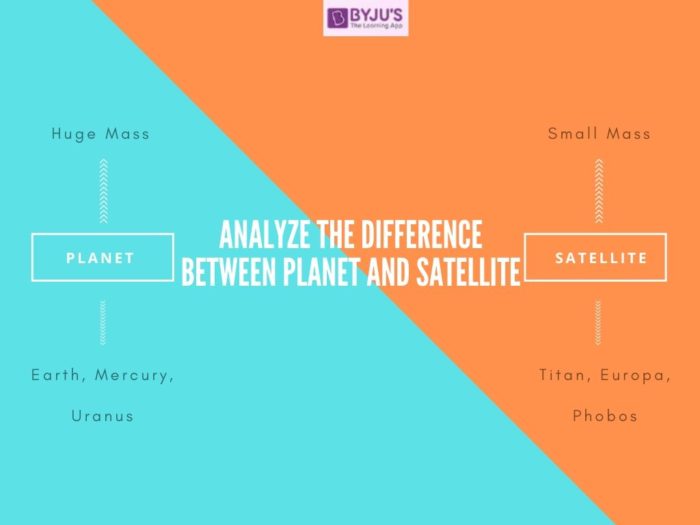Planets and Satellites are two astronomical bodies with many fundamental differences between them.
A planet is a body orbiting a star that is big enough to be rounded by its gravity but not massive to cause a thermonuclear reaction. On the other hand, a satellite is an object in space that orbits or circles around a larger entity. Out of this, there are two types of satellites: Natural and artificial.

This article will further highlight the differences between Planets and Satellites within the context of the IAS Exam.
Differences between Planet and Satellite
| Planet |
Satellite |
| As per modern definitions, an astronomical body orbiting a star can be classified as a planet. | Satellites both natural and artificial, orbit relatively close to planets or any other celestial body with a somewhat bigger mass. |
| The planet’s axial tilt is at an angle to the plane of its star’s equator. This causes the amount of light received in the hemisphere to vary throughout its span of rotation. | Satellites orbiting relatively close to the planets on uninclined circular orbits are thought to have been formed out of a collision between two astronomical bodies. |
| The terms ‘planet’ is derived from the Greek word “planetes” meaning “wanderer”. | The term ‘satellite’ is derived from the Latin word ‘satelles’ meaning ‘to follow” or “to attend to.” |
| Planets rotate around the invisible axes through their centres. Most of the planets in the solar system orbit the sun. | Natural Satellites in the Solar System are tidally locked to their respective planet, meaning that the same side of the natural satellite always faces its planet. |
| The planet’s massive size is responsible for the domination of the gravitational force over the electromagnetic force. This results in hydrostatic equilibrium. | The mass of satellites will always be smaller than that of planets and will rely upon the planet’s gravity for it to orbit. |
| Examples of planets are Earth, Jupiter, Saturn, etc. | Examples of satellites are the Moon orbiting the Earth, Titan orbiting Saturn and Europa orbiting Jupiter. |
After learning about the difference between Planets and Satellites, refer to the below-given links to comprehensively prepare for the Science and Technology Section of the Civil Service Exam.
- Science and Technology Notes for UPSC
- How to Tackle Science and Technology for UPSC
- General Science Preparation for UPSC
- Science and Technology MCQs for UPSC
Aspirants can find more Difference Between Articles by visiting the linked page.
Difference Between Planet and Satellite – Download PDF Here
FAQ about Planet and Satellite
How many planets are there in our solar system?
What are the types of satellites, and give an example?
Become familiar with the general pattern of the IAS Exam by visiting the UPSC Syllabus page. For more exam-related preparation materials, refer to the links given in the table below:
Related Links
| NCERT Books Free Download | UPSC Exam Pattern | NCERT Notes for UPSC |
| Intangible Cultural Heritage | Indian Personalities | PIB Summary and Analysis |
| Biological Weathering | Safety Valve Theory | WPI Index |
Comments